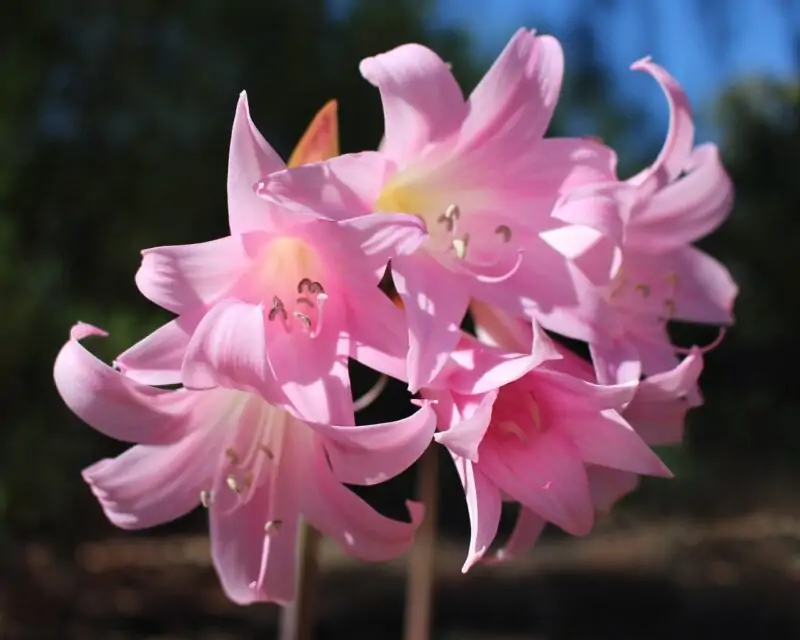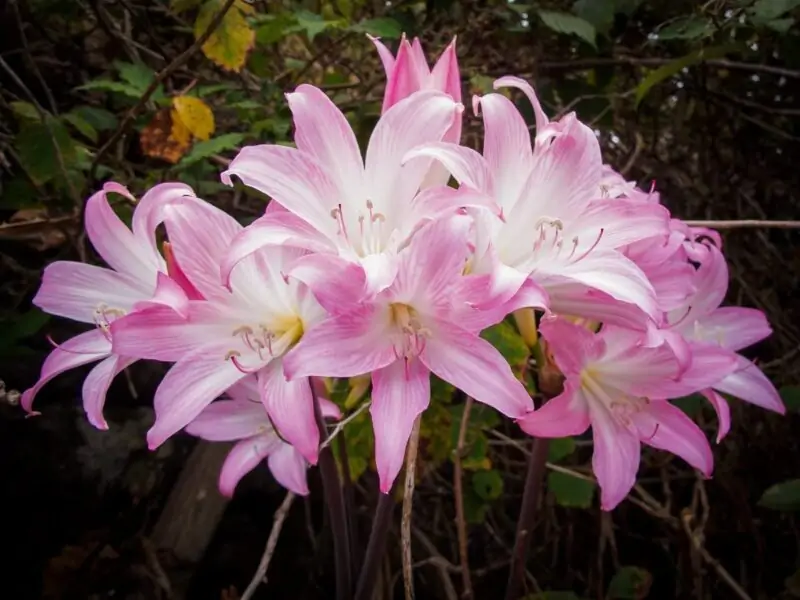Growing Amaryllis Belladonna: A Belladonna Lily Plant Care Guide

Overview of the Belladonna Lily
Hello there, folks! Today, we’re diving head-first into the world of the belladonna lily. This perennial bulb, part of the Amaryllidaceae family, is a favorite among many gardeners due to its stunning blooms and captivating fragrance. You might say it’s the garden’s belle of the ball, a really beautiful lady catching eyes and turning heads with its showy flowers. As interesting as it is beautiful, this beauty has more up its sleeve than you might imagine.
A Rich Story
The belladonna has quite a few aliases. These vary from the elegant “Jersey Lily” to the slightly humorous “Naked Ladies,” and the time-telling “August Lily.” Each name for this plant is an interesting story. This flowering plant species showcases its diverse character and ability to adapt to different climates and environments.
The Belladonna: A Closer Look
Description and Characteristics
This beauty is an intriguing plant with an equally interesting lifecycle. It produces a tall, leafless stalk that stands proudly at 1 to 2 feet in height. Atop this stalk, clusters of fragrant, trumpet-shaped flowers unfurl in varying shades of pink. Blooming in late summer, it’s like a fireworks display when everything else in the garden is starting to wind down. However, the green, strap-shaped leaves are a no-show during the blooming period. They come out in spring but wither away before the flowers appear, leading to the nickname “naked lady.”
History and Origin
Belladonna lily’s journey through time and space is a tale worth telling. Native to South Africa, it has found its way into many corners of the world, from California’s coastal gardens to the quaint landscapes of the Isle of Jersey. Its adaptability and resilience are as impressive as its beauty, making it a favored addition to various types of gardens.
Significance and Symbolism
Symbols and meanings are part of the allure of any flower, and this stunning flower is no exception. It’s seen as a symbol of beauty, resilience, and grace. Its ability to bloom intensely under the heat of late summer represents strength and endurance. And doesn’t that resonate with us as we navigate life’s highs and lows?
Common Names
Jersey Lily
The nickname, “Jersey Lily,” came about through a shipwrecked sailor’s tale. Legend has it that a sailor washed ashore on the Isle of Jersey with a belladonna lily bulb. The lily flourished, earning its new name.
Naked Ladies
This peculiar name stems from its peculiar growth habit. The foliage appears in spring, only to die back during the growing season. This leaves behind a bare flower stalk just in time for the flowers to bloom, hence the “naked” appearance. Due to the naked appearance, the comparison adds a touch of humor and intrigue to this garden favorite.
August Lily
Lastly, the name “August Lily” is all about timing. These beauties tend to show their bright pink, trumpet-shaped flowers in late summer, often peaking in August. The name is a testament to their seasonal rhythm, an annual spectacle of color and fragrance that many look forward to.
Growing Belladonna Lily

Ideal Conditions
These plants are versatile and relatively easy to grow. They favor a spot with full sun and well-drained soil. This plant species is also quite cold hardy. So, even if the climate feels more like a freezer than a tropical paradise during winter, your fragrant flower will likely survive.
Planting and Caring
So, you’ve got your bulbs and a sunny spot picked out in your garden. Now what? Here’s the low-down: plant them in spring or early summer with the neck of the bulb at the surface of the soil. They prefer their space, so keep them about a foot apart. As for care? Minimal! Make sure the soil drains well, and you’re good to go. These ladies are independent and low-maintenance.
Common Challenges and Solutions
Just like baking a perfect pie, growing these ladies can have its challenges. Maybe the blooms aren’t as vibrant, or the stalks aren’t standing tall. Common culprits could be poor draining or lack of sunlight. Fix the drainage, move the bulb to a sunnier spot, and you’ll be back in business. Easy fixes for a potentially fabulous flower payoff!
Belladonna Lilies in the Landscape
Landscaping Ideas
Think of lilies as the sprinkles on a cupcake – they add that extra pizzazz. Try planting them in groups in a sunny border or rock garden. You could even pot them as eye-catching potted plants on your patio. Their tall, leafless stalks, topped with clusters of vibrant pink flowers, create a dramatic vertical element in any outdoor garden setting.
Companion Plants
Now, these blooms are beautiful on their own, but pairing them with some friendly neighbors can create a truly breathtaking garden tableau. Companions like low-growing annuals or foliage plants that stay green during the lily’s dormancy period can mask the dying leaves and keep the garden looking fresh. Also, these companions can provide a contrast that makes those pink and white belladonna blooms pop!
FAQs
These flowers love the sun, so a spot with full exposure is ideal. They also require well-drained soil to prevent waterlogging. They’re pretty hardy and can tolerate frost, making them a good choice for colder climates.
The “Naked Ladies” nickname comes from the plant’s unique growth cycle. The leaves appear first and die back, leaving a bare stalk when the flowers bloom. The “Jersey Lily” name is linked to the Isle of Jersey, where the lily was said to be introduced by a shipwrecked sailor.
In spring, when the dull-green leaves appear, ensure your lily has plenty of water. However, when the foliage dies back, reduce watering. During flowering, minimal care is required – just sit back and enjoy the beautiful display!
Thankfully, these plants don’t have many issues with pests or diseases. Just watch out for poor drainage, as it can cause bulb rot. Keeping the soil well-drained and not overly wet will help keep your lilies healthy.
Absolutely! Companion plants that offer contrasting colors and stay green during the lily’s dormancy period are ideal. Think low-growing annuals or perennials, like creeping thyme or sedum, which will create a lovely carpet effect. That’s right; your garden can have its own magic carpet ride!
Conclusion
Growing the blooms of belladonna lily isn’t just about adding a dash of color to your garden; it’s about embracing a plant that’s as resilient as it is charming. From the blooming period in late summer to the wintertime when the plant goes into dormancy, this stunning bloom stays true to its course. It’s the silent promise of beautiful blooms to come, a sight for sore eyes when the summer sun blazes in all its glory.